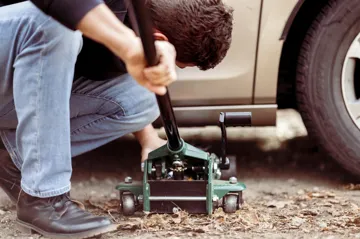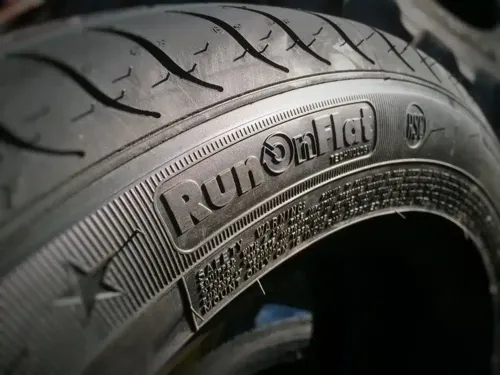What to Do If You Get a Flat Tyre?
Discover essential tips on staying safe, changing a tyre, and getting back on the road.
Posted on

A flat tyre can happen to anyone, often at the most inconvenient times. Whether you're on a busy motorway or a quiet country road, knowing how to handle a flat tyre is essential for staying safe and getting back on the road quickly. This step-by-step guide will walk you through what to do if you get a flat tyre, from initial safety precautions to replacing the tyre or seeking assistance.
1. Stay Calm and Find a Safe Spot to Stop
The first thing to remember if you get a flat tyre is to remain calm. Panicking can lead to rash decisions that put you in more danger. If you feel your tyre go flat, follow these steps:
- Slow down gradually: Don’t slam on the brakes; instead, ease off the accelerator and slowly reduce your speed.
- Look for a safe place to stop: Ideally, you want to pull over to a flat, stable area away from traffic. A parking lot, rest area, or the shoulder of a straight road are good options.
- Avoid stopping on a curve or incline: These areas can be hazardous as other drivers may not see you in time to avoid a collision.
- Turn on your hazard lights: This alerts other drivers to your situation, helping them see you from a distance and avoid your vehicle.
2. Ensure Your Safety Before Exiting the Vehicle
Before you get out of the car, it’s important to prioritize safety:
- Turn on your hazard lights to warn other drivers that you’re stopped.
- Engage the parking brake to prevent your vehicle from rolling.
- If you have one, place a reflective triangle or flares a few feet behind your vehicle to increase visibility, especially in low-light conditions or on busy roads.
Make sure you check your surroundings carefully before exiting the vehicle, especially if you're on a busy road or motorway.
3. Assess the Damage
Once you’re safely stopped and out of the car, assess the situation. Walk around your vehicle and inspect the tyre to determine the extent of the damage:
- Is the tyre completely flat or just low on air?
- Is there visible damage like a puncture, cut, or tear?
- Is the rim or wheel damaged?
If the tyre is completely flat or the damage is significant, it will likely need to be changed or repaired before you can continue driving.
4. Decide on Your Next Steps

After assessing the damage, you need to decide whether you’re going to change the tyre yourself, call for roadside assistance, or repair the flat if it’s a minor issue.
- Changing the tyre yourself: If you have a spare tyre and the necessary tools, and you're in a safe location, you can attempt to change the tyre.
- Calling mobile tyre fitting: If you're unsure of how to change a tyre or don’t feel comfortable doing so, it’s safer to call for help. Most roadside assistance services can quickly change a flat tyre or tow your vehicle if necessary.
- Using a tyre repair kit: If the damage is minor (like a small puncture), and you have a tyre repair kit, you may be able to patch the tyre temporarily until you can get to a mechanic.
5. How to Change a Flat Tyre
If you decide to change the flat tyre yourself, follow these steps:
Tools You'll Need:
- Spare Tyre
- Jack
- Lug wrench
- Vehicle owner’s manual (for reference)
Step-by-Step Instructions:
- Loosen the lug nuts: Before lifting the vehicle, use the lug wrench to slightly loosen the lug nuts on the flat tyre. Turn them counterclockwise, but don’t remove them completely yet.
- Position the jack: Place the jack under the vehicle at the recommended lifting point (usually near the flat tyre). Refer to your owner’s manual for the correct location. Make sure the jack is stable on the ground before lifting.
- Lift the vehicle: Use the jack to lift the vehicle until the flat tyre is about 6 inches off the ground. Ensure the vehicle is stable before proceeding.
- Remove the lug nuts: Fully unscrew the loosened lug nuts and set them aside. Keep them in a safe spot where they won’t roll away.
- Carefully pull the flat tyre off the wheel hub and set it aside.: Carefully pull the flat tyre off the wheel hub and set it aside.
- Install the spare tyre: Align the spare tyre with the wheel bolts and slide it onto the hub. Push it in place until the wheel is secure.
- Hand-tighten the lug nuts: Start threading the lug nuts onto the bolts by hand. Tighten them as much as you can by hand before lowering the vehicle.
- Lower the vehicle: Use the jack to carefully lower the vehicle until the spare tyre is in full contact with the ground, but don’t remove the jack yet.
- Tighten the lug nuts: Once the vehicle is partially lowered, use the lug wrench to fully tighten the lug nuts in a crisscross or star pattern to ensure even pressure on the tyre.
- Lower the vehicle completely: Remove the jack and fully lower the vehicle. Check the lug nuts again to ensure they’re as tight as possible.
- Store the flat tyre: Place the flat tyre, jack, and lug wrench back in your vehicle.
Now, your spare tyre is installed, and you’re ready to continue your journey. Keep in mind that spare tyres are often temporary and not designed for long-distance or high-speed driving. Head to the nearest service station or tyre shop to have the flat repaired or replaced as soon as possible.
6. If You Don’t Have a Spare Tyre
If you don’t have a spare tyre, you’ll need to seek other options. Here’s what you can do:
- Call for roadside assistance: If you have a membership with an auto club or access to roadside assistance through your insurance, this is the best option to get immediate help.
- Use a tyre repair kit: Some vehicles come equipped with a tyre repair kit that allows you to seal minor punctures and reinflate the tyre temporarily.
- Use a mobile tyre service: In some areas, you can call a mobile tyre-fitting service to replace your tyre on-site.
7. Preventing Future Flat Tyres
Flat tyres can happen unexpectedly, but you can reduce the risk by taking some preventative measures:
- Check tyre pressure regularly: Under-inflated tyres are more prone to blowouts and punctures. Make sure your tyres are properly inflated to the recommended levels.
- Inspect your tyres for damage: Regularly check your tyres for cuts, bulges, or foreign objects that could lead to a flat.
- Rotate your tyres: Rotating your tyres regularly ensures even wear, which reduces the likelihood of a flat.
- Avoid driving over debris or potholes: Being cautious of the road conditions can help prevent tyre damage.
Conclusion
Getting a flat tyre can be stressful, but knowing what to do can make the situation much easier to handle. By following these steps, you can stay safe, change the tyre yourself if needed, and get back on the road quickly. Regular tyre maintenance and staying prepared can help reduce the chances of a flat in the future, but if it does happen, you’ll be ready to handle it confidently.
Stay safe and be sure to keep all necessary tools in your vehicle so you're prepared for any tyre-related issues.









